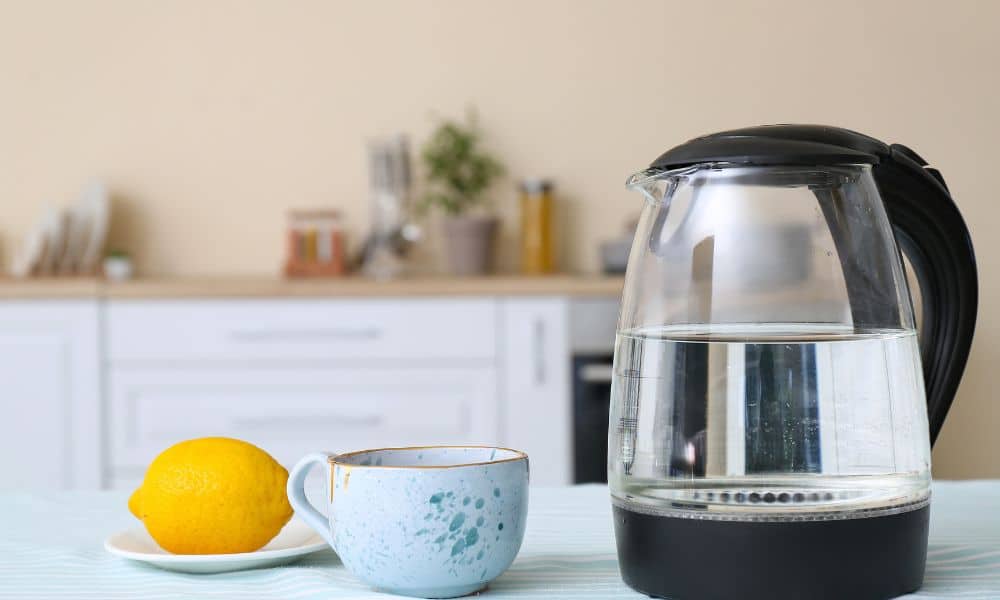I still remember my first kettle. It was a housewarming gift from my aunt. Cream-colored. Glossy. Made of stainless steel. It sat proudly on the counter and whistled me into each morning. Back then, I was new to home life—learning to fix taps and find spots for teabags. That kettle became a quiet friend. But one day, it slowed down. The water tasted strange. Inside, I saw a white crust. Limescale. I had no idea kettles needed care. Today, descaling is second nature. I’ve tried many tricks, but one method always wins—lemon. Let me show you how to descale a kettle with a lemon.
What You’ll Need
Before we begin, let’s get everything ready. You won’t need much.
- 1 fresh lemon (medium or large)
- A knife and cutting board
- Tap water
- A soft cloth or sponge
- A clean towel
That’s it. No chemicals. No harsh smells. Just something already in your fruit bowl.
Step-by-Step: How to Descale a Kettle with a Lemon
01. Rinse Out the Kettle
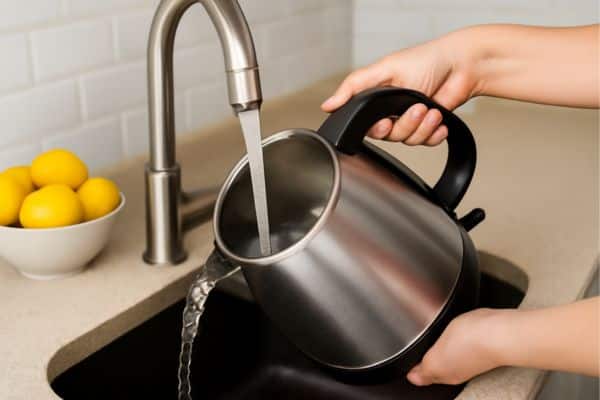
Start with an empty pot. Pour out any leftover water.
Please give it a quick rinse. This helps get rid of loose particles or old tea stains. You want a clean surface for the lemon juice to work on.
02. Slice the Lemon
Take your lemon and cut it in half.
You’ll use the juice, pulp, and even the peel. It are full of citric acid, which breaks down mineral build-up without scratching the surface. It’s gentle but effective.
03. Squeeze the Lemon Juice into the Kettle
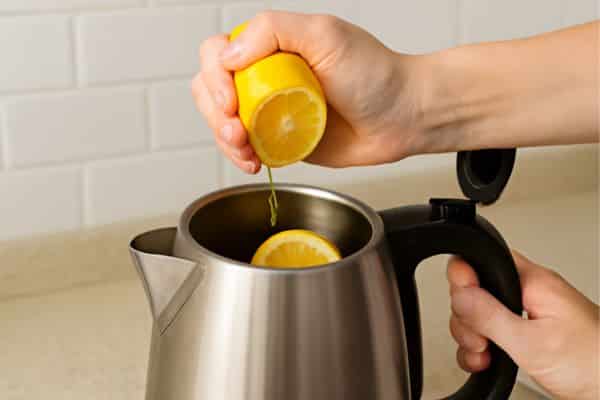
Hold one half over the kettle. Squeeze in all the juice. Then do the same with the other half.
Drop the squeezed halves inside. The peel and pulp still have acid and oils that help with cleaning. Plus, they make the whole thing smell fresh and bright, just like brewing in the Best Non Toxic Electric Tea Kettle for a clean, worry-free pour every time.
04. Add Water
Fill the kettle about halfway with tap water. Just enough to cover the limescale areas. Don’t fill it to the top. You want the lemon to concentrate its magic on the parts that matter.
05. Boil the Mixture
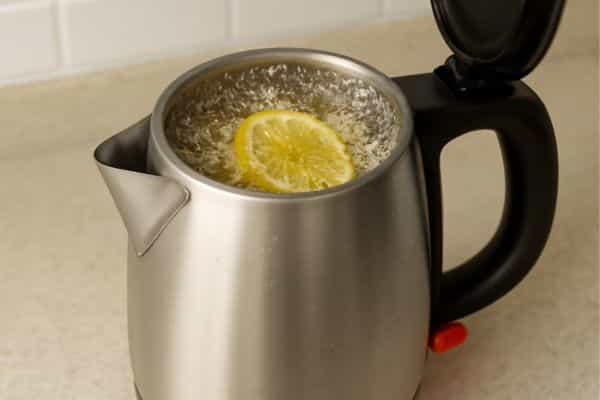
Turn on the kettle and bring the lemon-water mix to a boil.
Once it clicks off, don’t touch it. Let the hot water and lemon sit inside for at least 30 minutes. I sometimes leave it for an hour if there’s a lot of scale.
This soak loosens the build-up and allows the citric acid to dissolve the minerals.
06. Scrub Gently
After the soak, open the lid. Grab a soft cloth or non-abrasive sponge.
Wipe the inside gently. You’ll see the scale peeling off or softening into flakes. Don’t scrub too hard. Let the lemon do most of the work.
For tough spots, rub with the halves you dropped in earlier.
07. Rinse Thoroughly
Once you’re happy with the result, pour everything out.
Rinse the kettle well with fresh water. Fill it, swirl, and pour. Do this 2-3 times to make sure no pulp or acid remains.
08. Boil Fresh Water
Fill the kettle with clean water and bring it to a full boil.
Then discard this batch. It clears out any leftover taste or particles. Now your pot is fresh, clean, and ready for another round of tea or coffee.
Tips for Getting It Just Right
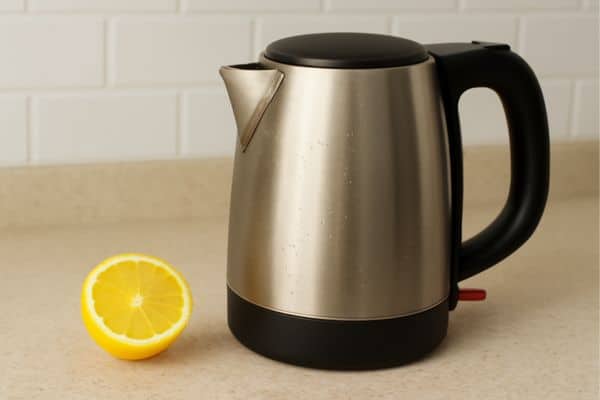
Over the years, I’ve picked up a few small tricks. They make the process easier and the result better.
Use Real Lemons
Bottled lemon juice can work, but I always prefer fresh. The oils in the peel help polish the inside. The pulp adds extra acid. And nothing beats that real citrus smell.
Don’t Rush the Soak
Time is your friend here. The longer the mixture sits, the softer the scale gets. I sometimes do a second boil if the build-up is thick, followed by another soak.
Avoid Abrasive Tools
Steel wool or rough sponges might scratch the inside of your kettle. These scratches can trap more limescale over time. Stick with a soft cloth or a silicone scrubber.
Make It a Habit
I descale my kettle once a month. It’s a small thing, but it keeps the water fresh and the pot running smoothly. If your water is hard, you might need to do it more often.
Add Lemon Peels for Shine
After descaling, I sometimes boil plain water with just lemon peels.
It doesn’t descale, but it gives the kettle a nice polish and leaves the kitchen smelling amazing.
Why Lemon Works So Well
Lemon contains citric acid. This breaks down calcium carbonate, the main stuff in limescale.
It’s also antibacterial, gentle on metal, and 100% natural. You’re not just cleaning the pot —you’re caring for it in the kindest way possible.
Plus, They are cheap, easy to find, and biodegradable. There’s no plastic bottle to throw out. No labels to read. Just slice, squeeze, boil, and rinse.
Why I Prefer Lemon Over Vinegar
I’ve used vinegar before. It works well. But I always go back to lemon. Why? Two reasons.
First, the smell. Vinegar leaves a sharp, sour scent that lingers for hours. It smells like you’re cleaning in a citrus grove.
Second, the feeling. It feels joyful. It’s like baking a cake or polishing a family photo. Not just about function. It’s about care.
A Few Words for Fellow Kettle Lovers
A kettle is more than just a kitchen tool. It’s where mornings begin. Where tired evenings end. It hums in the background while you daydream or plan your week. It deserves a little love now and then.
Descaling might sound like a chore, but I see it as a pause. A moment to slow down. To care for something simple, warm, and useful. The next time you notice your pot slowing down, don’t wait. Grab a lemon and give it some love. You’ll hear the difference. You’ll taste it too.
Final Thoughts
Descaling a kettle with lemon is easy, fast, and satisfying. You only need one lemon and a bit of time. No harsh smells. No special tools. Just a simple act of care that makes your kitchen feel a little brighter. Next time your pot needs a refresh, skip the store-bought cleaner. Go natural. Go sunny.

